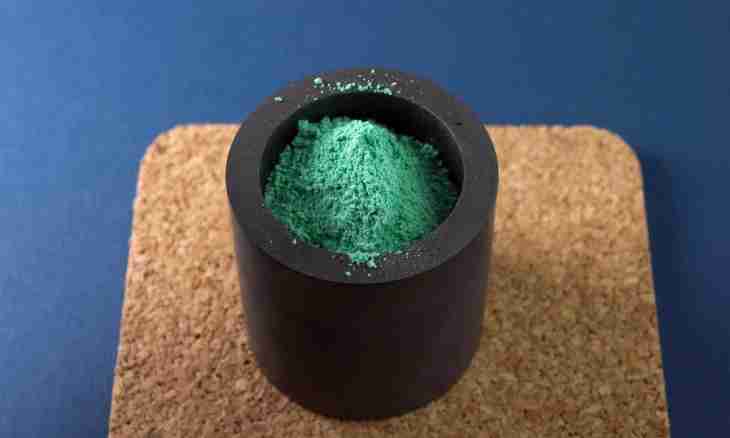There are 3 types of oxide of copper. They differ from each other in valency. Respectively, there are monovalent, bivalent and trivalent oxides of copper. Each of oxides has the chemical properties.
Instruction
1. Oxide of copper (I) is Cu2O. In the nature he can be met in the form of cuprite mineral. Its such names as copper protoxide, gemioksid are also known to copper and dicopper oxide. Oxide of copper (I) belongs to group of amphoteric oxides.
Chemical properties
Cu2O does not react with water. Oxide of copper (I) dissociates in the minimum degree: Cu2O+H2O=2Cu (+) + can be transferred to 2OH-.Cu2O to solution the next ways: - Oxidation: Cu2O+6HNO3=2Cu(NO3)2+3H2O+2NO2;2Cu2O+8HCl+O2=4CuCl2+4H2O. - Reaction with the concentrated hydrochloric acid: Æu2O+4HCl=2H[CuCl2] + H2O. - Reaction between oxide of copper (I) and the concentrated alkali: Cu2O+2OH (-) + H2O=2 [Cu(OH)2] (-).-Reaction with the concentrated solutions of salts of ammonium: Cu2O+2NH4 (+) =2 [Cu(H2O) (NH3)] (+). - Reaction with the concentrated ammonia hydrate: Cu2O+4(NH3*H2O)=2 [Cu(NH3)2] OH+3H2O.Cu2O in water solution can carry out the following reactions: - Oxidation by oxygen to Cu(OH)2:2Cu2O+4H2O+O2=4Cu(OH)2. - In reaction with the diluted galogenvodorodny acids (instead of HHal it is possible to deliver to Cl, I, Br) it is formed copper halogenides: Cu2O+2HHal=2CuHal+H2O. - Reaction with the diluted sulfuric acid is disproportionation. That is oxide of copper (I) is both oxidizer and reducer at the same time: Cu2O+H2SO4=CuSO4+Cu+H2O. - Reaction of restoration to Cu sodium hydrosulphite, or any other typical reducers: 2Cu2O+2NaHSO3=4Cu+Na2SO4+H2SO4. Reactions with azidohydrogen: - Reaction when cooling 10-15os: Æu2O+5HN3=2Cu(N3) 2+H2O+NH3+N2. - Reaction at a temperature 20-25os: Su2O+2HN3=2CuN3+H2O.Reaktsii when heating: - Decomposition at 1800 OS: 2Cu2O=4Cu+O2. - Reaction with sulfur: 2Cu2O+3S=2Cu2S+SO2 (temperature more than 600 wasps); 2Cu2O+Cu2S=6Cu+SO2 (temperature 1200-1300os).-In hydrogen current when heating carbon oxide reacts with aluminum: Cu2O+H2=2Cu+H2O (temperature is higher than 250 wasps); Cu2O+CO=2Cu+CO2 (temperature 250-300os); 3Cu2O+2Al=6Cu+2Al2O3 (temperature of 1000 wasps)
2. Oxide of copper (II) is CuO. The name copper oxide is also known. The usual schools (which are not specializing in chemistry) study it. It is the main oxide, bivalent. In the nature oxide of copper (II) meets in the form of mineral of the melakonit or it is called still tenorite.
Chemical properties
- Oxide of copper (II) decays when heating to 1100 wasps: 2CuO=2Cu+O2. - Oxide of copper reacts with acids: CuO+2HNO3=Cu(NO3)2+H2O; CuO+H2SO4=CuSO4+H2O is receiving copper vitriol. - At reaction with hydroxides kuprata are formed: CuO+2NaOH=Na2CuO2+H2O. - Reactions of oxide of copper (II) with coal, carbon monoxide, ammonia and hydrogen are restoration reactions: 2CuO+C=2Cu+CO2.CuO+H2=Cu+H2O
3. Oxide of copper (III) - Cu2O3 - copper metal oxide. Is strong oxidizer.
Chemical properties
- Oxide of copper (III) is not dissolved in water. - Decomposition happens at influence of temperature: 2Cu2O3=4CuO+O2 (temperature of 400 wasps).-During reaction of oxide of copper (III) to chlorohydrogen there is a release of chlorine; - At reactions with alkalis red tetragidroksokuprata (III) are formed (unstable). Two last reactions quite difficult, their use meet only in main institutions.
